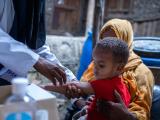Nov 12, 2002 (CIDRAP News) Nearly all local public healthdepartments have made some progress on bioterrorism preparedness in the pastyear, according to a recent online survey by the National Association of Countyand City Health Officials (NACCHO).
The most common preparedness steps included the developmentof relationships with other first responders, training and simulationexercises, and improvements in communication technology, the organizationreported in an "issue brief."
"Nearly all LPHAs [local public health agencies] aremoving forward to prepare their communities for bioterrorism and other publichealth threats and emergencies; however, the degree of progress and accomplishmentvaries greatly across the country," NACCHO stated.
NACCHO provided an online questionnaire from Aug 20 to Sep 3and used e-mail messages to invite a sample of local public health directors torespond. An estimated 1,626 directors received the questionnaire, which drew342 responses from 44 states.
About two-thirds of the respondents said their agencies hadmade progress in bioterrrorism and emergency preparedness planning in the pastyear, and almost a third said their response plans were complete, according tothe report. The stages of planning varied widely, with some agencies addressinghow to distribute supplies from the National Pharmaceutical Stockpile andothers doing preliminary needs assessments.
Almost half of the respondents reported new or increasedcollaboration with other first responders, including fire, police, andemergency personnel. "LPHAs and other first responders began meetingregularly for emergency planning in some jurisdictions and some have beguntraining and completing exercises together," the report says.
Likewise, almost half of the respondents said they hadprovided some staff training in bioterrorism preparedness or would offer suchtraining soon. Nearly a third of the agencies had planned or completedemergency response exercises, ranging from tabletop exercises to full-scalesimulations of bioterrorism events.
A quarter of the agencies had improved technology andequipment since Sep 11, 2001, NACCHO reported. Many had added new communicationequipment, such as high-speed Internet access, pagers, cell phones, and800-megahertz radios, and others had upgraded computer equipment and enhancedtheir laboratory capacities. Other improvements included the development of24-hour telephone hotlines.
For example, an Idaho official wrote, "Effective August12, 2002, the seven Idaho public health districts became the primary respondersto public health threats via the state communication systema 24/7 pager andteleconference system that brings all state and local agencies together onevery hazardous event. This district is on pager call 24/7 for both [state]alerts and local public health calls."
There was wide agreement that public health agencies arestill in the early stages of a "large, multi-year effort" to preparefor bioterrorism. The challenges they cited as most urgent were organizing andcommunicating with the community, staffing and training, and funding.
Many officials said they don't have enough staff to work onbioterrorism preparedness while maintaining efforts in other areas, and many"were searching for qualified professionals with skills in epidemiology,microbiology, information systems, risk communication, training, andspecialized nursing and environmental health skills."
Many health directors said they have been reluctant to hiremore staff members because of a lack of ongoing funding. A few had not yetreceived new federal funds.
The report concludes, "The common theme is that LPHAsare highly aware of the importance of bioterrorism preparedness and are movingforward to achieve it, although each is beginning at a different point andworking with a different set of resources and challenges."


















